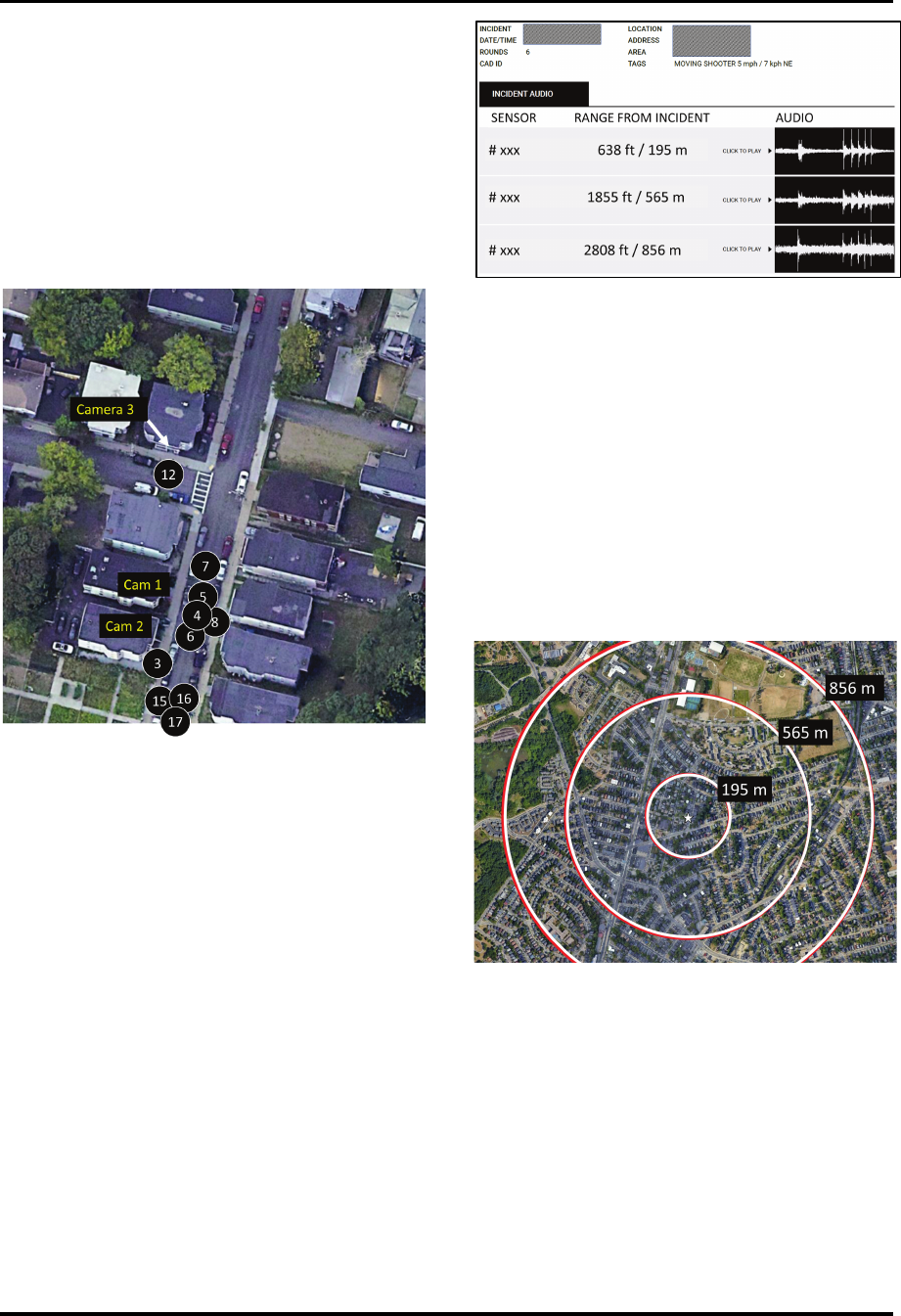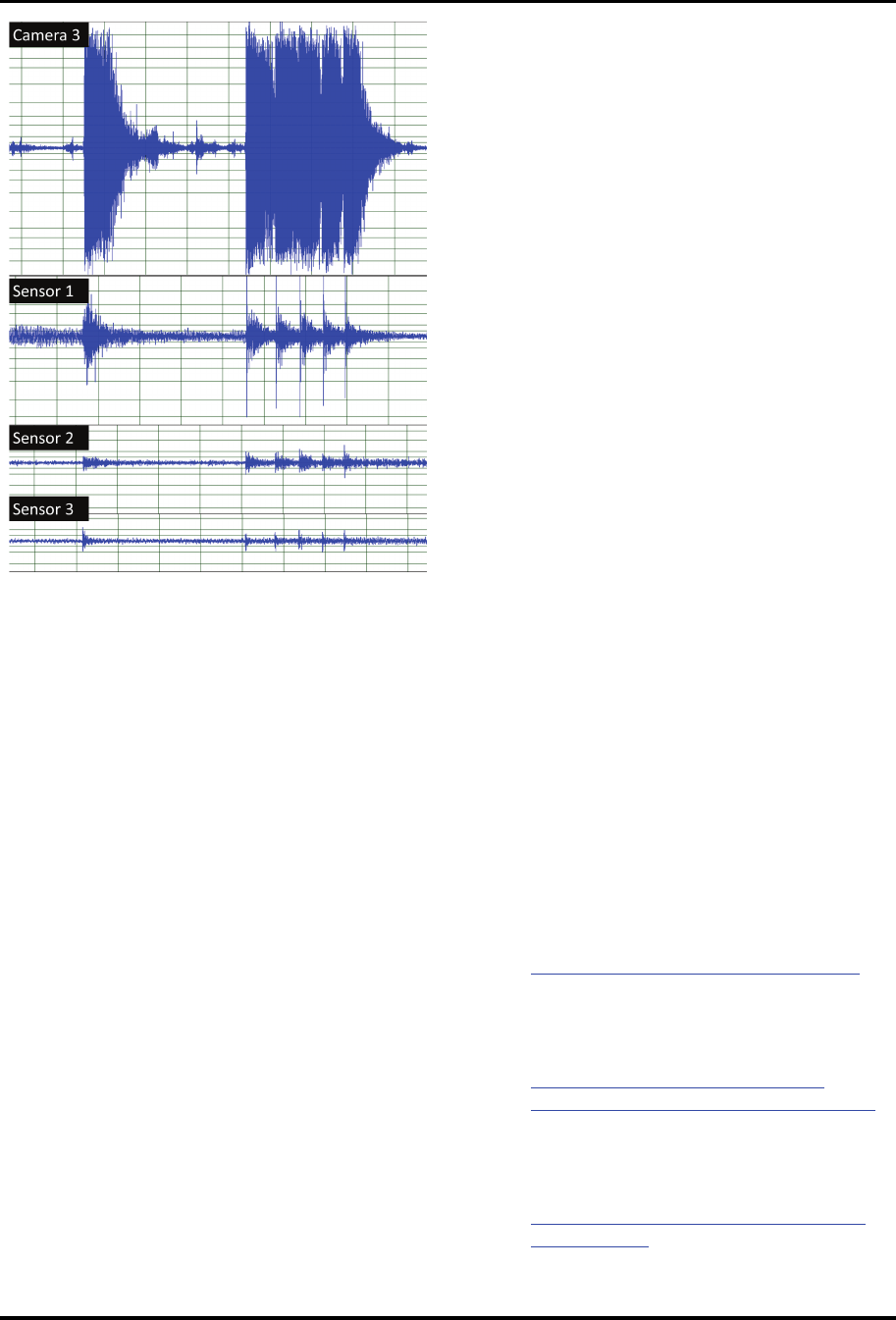
Audio Engineering Society
Convention Express Paper 122
Presented at the 155
th
Convention
2023 October 25-27, New York, USA
This Express Paper was selected on the basis of a submitted synopsis that has been peer-reviewed by at least two qualified anonymous
reviewers. The complete manuscript was not peer reviewed. This Express Paper has been reproduced from the author’s advance
manuscript without editing, corrections or consideration by the Review Board. The AES takes no responsibility for the contents.
This paper is available in the AES E-Library (http://www.aes.org/e-lib) all rights reserved. Reproduction of this paper, or any
portion thereof, is not permitted without direct permission from the Journal of the Audio Engineering Society.
Close and Distant Gunshot Recordings for Audio Forensic
Analysis
Robert C. Maher
Electrical & Computer Engineering, Montana State University, Bozeman, MT 59717-3780
Correspondence should be addressed to rmaher@montana.edu
ABSTRACT
We describe contemporary forensic interpretation of multiple concurrent gunshot audio recordings made in
acoustically complex surroundings. Criminal actions involving firearms are of ongoing concern to law
enforcement and the public. The U.S. FBI annually lists 166,000 criminal incidents involving firearms each year.
Meanwhile, over 80% of the large general-purpose law enforcement departments in the U.S. now use audio-
equipped body-worn cameras (BWCs), more than 135 communities use ShotSpotter
®
gunshot audio detection
systems, and tens of millions of private homes and businesses now have round-the-clock surveillance camera
systems—many of which also record audio. Thus, it is increasingly common for audio forensic examination of
gunshot incidents to include multiple concurrent audio recordings from a range of distances. A case study example
is presented.
1 Introduction
More and more criminal justice proceedings involve
audio forensic evidence in general, and gunshot audio
recordings in particular, due to (i) the large number of
law enforcement incidents each year in the United
States involving firearm use [1], (ii) the widespread
use of ShotSpotter
®
acoustic gunshot detection
systems [2], (iii) the millions of newly installed
residential security and doorbell camera systems with
audio capability [3], and (iv) the fact that most
general-purpose law enforcement agencies in the U.S.
are now utilizing body-worn cameras (BWCs) for all
routine work [4]. In fact, law enforcement
investigators now routinely canvass neighborhoods
and seek access to private surveillance recordings
following shootings and other criminal and civil
incidents involving gunshot sounds.
This work extends our previously reported research
sponsored by the U.S. National Institute of Justice in
nearfield gunshot acoustical analysis [5][6][7][8]. In
our current research, we focus upon audio forensic
gunshot audio cases in which concurrent recordings
from close and distant locations are available. For
example, a microphone within a few tens of meters of
the firearm, such as from a body-worn camera or a
nearby residential surveillance system, and a
concurrent recording from a few hundred meters
away obtained by ShotSpotter, a commercial gunshot
detection and localization system. With the known
“ground truth” from incident reports and the audio
recorded near the incident scene, we compare and
correlate information from ShotSpotter to develop
general recommendations and best practices for
improved audio forensic examination of gunshot
sounds recorded in complex acoustical environments.
I
n this paper, we briefly review the acoustical
properties of firearm sounds close to the gun and at
greater distances. Next, we present a case study
involving gunshots from an incident in which nearby
home surveillance cameras capture the gunshot
sounds, while simultaneously a ShotSpotter system
also detects the gunshots. Finally, we offer several

Maher Close and distant gunshot recordings for audio forensic analysis
AES 155
th
Convention, New York, USA
October 25-27, 2023
Page 2 of 8
remarks and suggestions regarding this type of
analysis, which we feel will become increasingly
common in audio forensics for the reasons mentioned
above.
2 Gunshot sounds
A conventional firearm uses a cartridge containing
gunpowder affixed with a bullet. Triggering the
primer in the cartridge rapidly combusts the
gunpowder within the confining cartridge, and the hot
combustion gases expand rapidly behind the bullet,
abruptly forcing the bullet and a jet of gas out of the
muzzle. The resulting muzzle blast causes an acoustic
pressure wave forming a loud pop sound lasting only
a few milliseconds. The muzzle blast is notably
directional: the on-axis sound level is more intense
than the level off to the side or toward the rear of the
firearm.
I
n summary, gunshot muzzle blast sounds are (a) high
amplitude (140+ dB SPL); (b) short in duration (2-3
milliseconds); (c) directional (sound level varies as a
function of azimuth with respect to gun barrel); and
(d)
r
ecorded with echoes and reverberation (acoustic
“impulse response” of the physical surroundings).
Th
e firearm itself may produce relatively subtle
mechanical sounds before, during, and after the bullet
is discharged. These sounds may include the
mechanical action of the gun, such as the trigger and
cocking mechanism, ejection of the spent cartridge,
and positioning of new ammunition. These
characteristic sounds may be of interest for forensic
study if the microphone is located sufficiently close
to the firearm to pick up the tell-tale sonic
information.
I
f the bullet emerges from the barrel traveling faster
than the speed of sound, the supersonic projectile
creates a ballistic shock wave. The shock wave itself
forms a radially propagating cone that trails the bullet
as it travels down range. The expanding face of the
shock wave cone moves through the air at the speed
of sound, and the passage of the shock wave may be
picked up by microphones located near the bullet’s
path [9].
2.1 Reflections and reverberation
Forensic audio recordings of gunshots generally
contain significant evidence of acoustical reflections
and reverberation. Distant recordings may not be line-
of-sight to the shooting location, so the effects of
diffraction and multi-path interference is also
expected.
As noted above, the muzzle blast sound produced by
a firearm lasts only a few milliseconds, but the
recorded gunshot sound often has energy lasting
hundreds of milliseconds due to the reverberation of
the recording scene. The acoustic clutter of the
reverberation can sometimes provide good
information about the acoustical surroundings, but, in
general, the specific acoustical characteristics of the
firearm itself are lost in the overlapping sound
reflections.
2.2 Effects of audio coding
Many sources of user generated recordings (UGR)
come from devices that use perceptual audio coding
(e.g., MP3 or MP4) between the microphone and the
digital storage system. Perceptual coders are designed
to maintain the perceived audio quality of the original
signal, but such coders are not intended to retain
objective waveform information that would be
desirable for forensic purposes, especially for
impulsive signals such as gunshots. Nevertheless,
perceptually-coded audio can provide useful timing
information within the constraints of the block size
and timing of the coding algorithm [10].
C
urrently, commercial gunshot detection systems
such as ShotSpotter appear to use conventional
uncompressed pulse-code modulation (PCM) to store
recorded audio. These recordings should therefore
have fewer concerns about waveform interpretation
and timing.
3 ShotSpotter system
The ShotSpotter system from SoundThinking
™
[2] is
a proprietary commercial system intended to detect
and localize the sound of a gunshot in the jurisdiction
of a law enforcement agency that subscribes to the
ShotSpotter service. The system consists of numerous
microphones and computer processing systems
(sensor nodes) installed and maintained by
ShotSpotter on rooftops, poles, and other structures in
the area of coverage. ShotSpotter’s dispatching
service, which uses information derived from the
acoustic sensors to make a judgement about the
occurrence of a sound that might be a gunshot,
provides an estimate of the geographic location of the
sound source. The proprietary system uses signal
processing algorithms and human listeners.
T
he geometric coordinates of the sensor nodes are
determined by ShotSpotter via an integrated GPS
receiver at each node. The local clock at each node is
also time synchronized via the integrated GPS
receiver. The sensor nodes include a processor system

Maher Close and distant gunshot recordings for audio forensic analysis
AES 155
th
Convention, New York, USA
October 25-27, 2023
Page 3 of 8
to record and analyze audio digitized from the
acoustic sensor system, and a communication system
links each sensor to ShotSpotter’s central office.
The basic theoretical principle of the ShotSpotter
system is that a loud, impulsive sound (such as a
gunshot) will travel through the air in all directions at
the speed of sound and will then be detected as the
sound arrives successively at the acoustic sensor
nodes in the vicinity. The time-of-arrival of the
impulsive sound at the various sensors depends upon
the distance between the sound source and the sensor,
the speed of sound in the vicinity, the presence of
structures, terrain, and other obstacles, and various
atmospheric effects such as wind and temperature
gradients.
The audio processing system at each sensor node
includes computer firmware that uses various
proprietary algorithms to estimate the likelihood that
a received sound is a gunshot, and not some other
common sound like a door slamming or a firecracker.
If the algorithm makes the determination that a
gunshot sound was observed, the system processes
the recorded waveform and estimates the arrival time
of the impulsive sound based upon the details of the
microphone signal, and this information is sent to the
ShotSpotter central office.
When the ShotSpotter central office has received
several contemporaneous reports from the acoustic
sensor nodes in a particular area, the central office
system automatically uses the time reports and the
known sensor locations to estimate the time
difference between the sound’s earliest arrival at a
sensor—presumably the sensor closest to the sound
source—and the arrival times at the other sensors.
The known location of each sensor and the measured
time-difference of arrival at each sensor can be used
to compute an estimate of the sound source location.
This mathematical computation is known as
multilateration [11].
In order to notify the law enforcement agency about
the shot detection so that the agency’s officers can be
dispatched, ShotSpotter reports an estimated location
in two dimensions (e.g. latitude and longitude). The
sound arrival times from at least three sensor nodes
are needed for the mathematical multilateration to
compute a set of possible sound source locations that
are consistent with the observed time-differences of
arrival, and at least four sensor nodes are needed to
reduce the ambiguity of the possible source positions
[12].
4 Case study: concurrent close and
distant gunshot recordings
An example gunshot audio recording scenario comes
from a case involving a ShotSpotter gunfire incident
activation and several home surveillance recordings.
The vicinity of the incident is shown in Figure 1.
The shooting incident appears to have started in the
rear of a residential dwelling where a party crowd had
gathered late in the evening. One of the surveillance
recordings (Camera 3) included audio of the gunshot
sounds, while two other surveillance recordings
(Cameras 1 & 2, video only) captured images of
firearms being discharged.
Based upon the available surveillance camera audio
recording (Camera 3), a total of 17 gunshots are
audible. The initial two gunshots, separated by about
5 seconds, occur clearly in the surveillance audio
recording.
The location where the shooting incident took place
was covered by a ShotSpotter gunshot detection
system. In fact, the sequence of shots resulted in three
separate ShotSpotter detection reports, as described
below. Thus, the incident includes both close and
distant recordings of the gunfire sounds.
In this incident, the entire sequence of gunshot sounds
was captured by the audio recording from Camera 3,
located approximately 50 meters north of the area of
the party. The audio recording from Camera 3 is
shown in Figure 2.

Maher Close and distant gunshot recordings for audio forensic analysis
AES 155
th
Convention, New York, USA
October 25-27, 2023
Page 4 of 8
Figure 1: View of the incident scene showing the general location of the surveillance cameras and the path of the
shooters moving through the area.
Figure 2: Audio recording and spectrogram from Camera 3 position. Total duration 33.5 seconds. Individual
gunshot reports 1-17 indicated manually. The three ShotSpotter activation detections are shown (SS1, SS2, SS3).

Maher Close and distant gunshot recordings for audio forensic analysis
AES 155
th
Convention, New York, USA
October 25-27, 2023
Page 5 of 8
By comparing the timing of the shots present in the
Camera 3 recording to the incident reports from the
ShotSpotter system, we can identify that the
ShotSpotter system did not activate on the first two
audible gunshots, and also missed shots 9, 10, 11, 13,
and 14, as seen in Figure 2.
The Camera 3 position recorded the gunshot audio,
but the accompanying video did not contain images
of the shooting scene. The Camera 1 and Camera 2
locations did capture images with visible muzzle
flashes and other evidence of the gunfire (e.g., Figure
3, Figure 4, and Figure 5), but Camera 1 and 2 did not
have audio recording capability.
Figure 3: Frame from Camera 1, handgun muzzle
flash (Shot 7 from Figure 2).
Figure 4: Frame from Camera 2, handgun muzzle
flash (Shot 9 from Figure 2).
Based upon the Camera 3 audio recording, the shots
visible in the Camera 1 and 2 videos, and other
evidence reported from the incident scene, we can
deduce the position of the firearms making all 17
audible shots. The shot locations are depicted in
Figure 6.
Figure 5: Frame from Camera 1, handgun muzzle
flash (Shot 10 from Figure 2).
Figure 6: Approximate location of shots based upon
video information (Camera 1 and 2) and related
evidence.
The ShotSpotter system issued three real time
incident reports related to this case. The incident
report SS1 detected six shots, which correspond to
shots 3-8 in the sequence. Incident report SS2
indicated one gunshot, corresponding to shot 12, and
report SS3 indicated three shots, corresponding to
shots 15-17. The locations identified by ShotSpotter’s
multilateration for the ten detected gunshots are
shown in Figure 7.
In this case, it is clear that ShotSpotter did not detect
all of the shots, and of the shots it did detect, the
locations differ somewhat from the “ground truth”
provided by the close cameras. While this may appear
to call into question the value of ShotSpotter for
comprehensive audio forensic assessment of a
shooting incident, it is important to note that the real
time detections and locations sent by ShotSpotter to

Maher Close and distant gunshot recordings for audio forensic analysis
AES 155
th
Convention, New York, USA
October 25-27, 2023
Page 6 of 8
the law enforcement agency happened within one
minute after the incident, and the position information
was adequate to dispatch officers to the correct
residential block. So, while the accuracy of the
ShotSpotter multilateration positions in this example
show a noticeable discrepancy for crime scene
reconstruction purposes, the system did fulfill the
original intent of ShotSpotter, namely, to identify the
incident location very quickly and with sufficient
precision to dispatch the law enforcement responders
to the scene.
Figure 7: Location of shots from ShotSpotter
detection reports. The ShotSpotter positions are
within approximately 20 meters of the actual
gunshot locations observed via Camera 1 and 2.
Figure 8 shows an example excerpt from ShotSpotter
report SS1, identifying shots 3-8 of the incident. The
report includes excerpts of the audio recorded at just
three sensors, although it is assumed that ShotSpotter
had additional sensors used in the multilateration
calculation that are not listed in the summary report.
For the three sensors included in the summary report,
the table indicates the distance from each sensor to
the shot location determined by the multilateration
algorithm. ShotSpotter generally does not identify the
precise location of its sensors due to concerns about
vandalism. In any case, it is evident that the gunshot
acoustical waveforms differ among the three sensors
due to the different range, azimuth, elevation,
obstructions, reflections, and other physical path
differences.
Figure 8: Example excerpt from ShotSpotter
incident report SS1 (shots 3-8).
In this example, the three sensors in the example were
at distances 195, 565, and 856 meters, respectively
(see Figure 9). The ShotSpotter recordings are
significantly farther away from the firearms than the
roughly 50 meters for the Camera 3 surveillance
recording, and therefore the distant recordings will
include the effects of acoustical
diffraction/shadowing and reflections/reverberation
due to the numerous buildings, trees, and other
obstacles between the shooting location and the
ShotSpotter sensor microphones.
Figure 9: Aerial view of the neighborhood
surrounding the shooting incident, with distances to
the three ShotSpotter sensors indicated in summary
report SS1 (Figure 8).
Comparing the audio recordings from the close
microphone (Camera 3) and the more distant
ShotSpotter sensors, the differences in amplitude and
reverberation characteristics become apparent, as
presented in Figure 10.

Maher Close and distant gunshot recordings for audio forensic analysis
AES 155
th
Convention, New York, USA
October 25-27, 2023
Page 7 of 8
Figure 10: Comparison of the waveforms for shots
3-8 recorded by the close Camera 3 microphone and
the three more distant ShotSpotter sensors.
5 Discussion and Conclusions
This case study presents an increasingly common
situation in which a shooting incident is recorded by
a microphone close to the scene and concurrently by
microphones located some greater distance away. The
“close” recording in this case was from a home
surveillance system with audio recording capability,
while the distant recordings were obtained by the
commercial ShotSpotter gunshot detection system
deployed in the particular jurisdiction.
The close recording is useful for distinguishing
gunshots from various other sounds at the incident
scene, and for establishing a reliable timeline.
The close recording is susceptible to amplitude
clipping and other waveshape distortions due to the
sound intensity of firearm muzzle blasts, and the
likelihood that the recording was captured with
perceptual audio coding (e.g., MP3, MP4, etc.).
The more distant recordings, such as the ShotSpotter
recordings from 195, 565, and 856 meters available
in this case, have the advantage that amplitude
clipping is unlikely. The ShotSpotter system also
provides multilateration calculations that can help
estimate the location of the gunfire with respect to the
precisely known positions of the sensors, along with
precisely known timestamps. However, as was
observed in this case, ShotSpotter’s algorithms may
not correctly identify every gunshot sound in a
shooting incident, and the multilateration position
uncertainty may be greater than the dimensions of the
shooting scene, particularly if the shooters are in
obstructed locations or are moving during the
incident. Based on this case study, the audio forensic
recommendation would be to compare and confirm
the ShotSpotter information with the close recording,
but clearly the timing and details of each shot in the
incident is represented fully with the close recording,
and incompletely with the ShotSpotter reports.
While this example includes ShotSpotter evidence, it
is also increasingly common to have user-generated
surveillance recordings or cellphone video from
locations near and far from a shooting incident, or the
close recording may come from a law enforcement
body-worn camera system. The additional
information provided by the multiple concurrent
recordings may be important in answering questions
about the circumstances of the incident, but the fact
that the locations of user devices is usually not known
very precisely, it is generally not feasible to get
reliable multilateration estimates of the gunshot
location using muzzle blast time-of-arrival in the
various recordings. Nevertheless, there may be useful
information available by comparing the timing of
multiple shots in the incident recordings, such as
addressing the sequence of shots if multiple shooters
were present [13].
References
[1] Federal Bureau of Investigation, Crime Data
Explorer, URL:
https://cde.ucr.cjis.gov/LATEST/webapp/,
September 1, 2023.
[2] SoundThinking
™
, ShotSpotter gunshot
detection technology, URL:
https://www.soundthinking.com/law-
enforcement/gunshot-detection-technology/,
September 1, 2023.
[3] Straits Research, "Doorbell Camera Market,"
URL:
https://straitsresearch.com/report/doorbell-
camera-market, September 1, 2023.

Maher Close and distant gunshot recordings for audio forensic analysis
AES 155
th
Convention, New York, USA
October 25-27, 2023
Page 8 of 8
[4] U.S. National Institute of Justice, "Research
on Body-Worn Cameras and Law
Enforcement," URL:
https://nij.ojp.gov/topics/articles/research-
body-worn-cameras-and-law-enforcement,
January 7, 2022.
[5] R.C. Maher and T.K. Routh, "Advancing
forensic analysis of gunshot acoustics,"
Preprint 9471, Proc. 139th Audio Engineering
Society Convention, New York, NY (2015).
[6] R.C. Maher and T.K. Routh, "Wideband audio
recordings of gunshots: waveforms and
repeatability," Preprint 9634, Proc. 141st
Audio Engineering Society Convention, Los
Angeles, CA (2016).
[7] R.C. Maher, "Shot-to-shot variation in
gunshot acoustics experiments," elib 20461,
Proc. 2019 Audio Engineering Society
International Conference on Audio Forensics,
Porto, Portugal (2019).
[8] B.F. Miller, F.A. Robertson, and R.C. Maher,
"Forensic handling of user generated audio
recordings," Preprint 10515, Proc. 151st
Audio Engineering Society Convention,
Online (2021).
[9] R.C. Maher and S.R. Shaw, "Deciphering
gunshot recordings," Proc. Audio Engineering
Society 33rd Conference, Audio Forensics—
Theory and Practice, Denver, CO (2008).
[10] R.C. Maher and S.R. Shaw, "Gunshot
recordings from digital voice recorders," Proc.
Audio Engineering Society 54th Conference,
Audio Forensics—Techniques, Technologies,
and Practice, London, UK (2014).
[11] R.C. Maher and E.R. Hoerr, "Audio Forensic
Gunshot Analysis and Multilateration,"
Preprint 10100, Proc. 145th Audio
Engineering Society Convention, New York,
NY (2018).
[12] R. Calhoun and S. Lamkin, "Determining the
Source Location of Gunshots From Digital
Recordings," Express Paper 18, Proc. 153
rd
Audio Engineering Society Convention, New
York, NY (2022).
[13] R.C. Maher, "Forensic interpretation and
processing of user generated audio
recordings," Preprint 10419, Proc. 149th
Audio Engineering Society Convention, New
York, NY, Online (2020).
